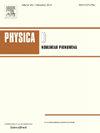Hirota方程局域波解的调制不稳定性、分类和动力学性质
IF 2.9
3区 数学
Q1 MATHEMATICS, APPLIED
引用次数: 0
摘要
本文引入广义摄动(n, n -n)-fold达布变换(gDT)对Hirota方程进行了研究,该方程被认为是比NLS方程更能准确描述波在海洋和光纤中的传播的物理模型。首先,我们分析了Hirota方程的调制不稳定性,建立了产生不同局域波的机理。然后,利用(n, n -n)倍gDT,我们得到了丰富的局域波解,包括高阶异常波、高阶周期波及其相互作用。对这些解的动力学性质进行了数值和理论研究。在详细的数值和理论分析的基础上,根据结构对高阶rw进行了分类。特别是对于一阶rw,我们用等高线法给出了其长度和宽度的解析公式。对于二阶rw,我们通过大参数渐近分析证明了当调制参数趋于无穷时,分裂后的三个一阶rw是相同的。本文所采用的方法可以推广到构造其他非线性系统的局域波。所得结果是新的,可为理解流体、等离子体、非线性光学和玻色-爱因斯坦凝聚中的相关异常波现象提供新的视角或参考。本文章由计算机程序翻译,如有差异,请以英文原文为准。
The modulational instability, classifications and dynamical properties of the localized wave solutions in the Hirota equation
In this paper, we introduce the generalized perturbation (-)-fold Darboux transformation (gDT) to investigate the Hirota equation, which has been viewed as a better physical model to accurately describe wave propagations in the ocean and optical fibers than the NLS equation. Firstly, we analyze the modulational instability and build the mechanism of generating different localized waves for the Hirota equation. Then, by using (-)-fold gDT, we obtain abundant localized wave solutions, including higher-order rogue waves (RWs), higher-order periodic waves and their interactions. Dynamical properties of these solutions are investigated numerically and theoretically. Based on the detailed numerical and theoretical analysis, we make a classification of the higher-order RWs based on their structures. In particular, for the first-order RWs, we give the analytical formulas of their length and width via the contour line method. And for the second-order RWs, we prove that the three first-order RWs after splitting are the same when the modulation parameters tend to infinity via the large-parameter asymptotic analysis. The method adopted here can be extended to construct localized waves of other nonlinear systems. The results obtained are new and they may provide a new perspective or reference in understanding the related rogue wave phenomenon in fluids, plasmas, nonlinear optics and Bose–Einstein condensation.
求助全文
通过发布文献求助,成功后即可免费获取论文全文。
去求助
来源期刊

Physica D: Nonlinear Phenomena
物理-物理:数学物理
CiteScore
7.30
自引率
7.50%
发文量
213
审稿时长
65 days
期刊介绍:
Physica D (Nonlinear Phenomena) publishes research and review articles reporting on experimental and theoretical works, techniques and ideas that advance the understanding of nonlinear phenomena. Topics encompass wave motion in physical, chemical and biological systems; physical or biological phenomena governed by nonlinear field equations, including hydrodynamics and turbulence; pattern formation and cooperative phenomena; instability, bifurcations, chaos, and space-time disorder; integrable/Hamiltonian systems; asymptotic analysis and, more generally, mathematical methods for nonlinear systems.
 求助内容:
求助内容: 应助结果提醒方式:
应助结果提醒方式:


